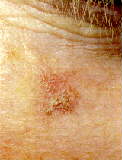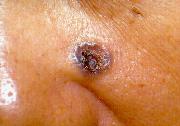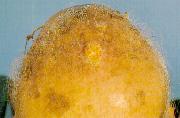
Fig.2 Solar keratosis

Fig.3 Basal cell carcinoma

Fig.4 Squamous cell carcinoma
Those elderly persons who had extensive sun exposure earlier in their life might develop pre-cancerous skin growths called solar keratoses Fig.2 and skin cancers like basal cell carcinomas and squamous cell carcinomas. Basal cell carcinomas and squamous cell carcinomas most commonly appear on the face. They start as small bumps and gradually enlarge, until they ulcerate. They can be pink or black in colour. See your doctor if you have any enlarging skin growth or a non-healing sore.
There are several types of skin cancers. The commonest is called basal cell carcinoma Fig.3 which appears as a small shiny growth with a central ulcer or depression. This is a slow growing cancer.
Another type of cancer is squamous cell carcinoma Fig.4. They appear as red scaly patches or pinkish growths. Sometimes they can be very large and raised.
Cancerous moles are less common but they tend to spread quickly if not treated. They appear as moles with irregular borders, irregular colours and lopsided shapes.
If you are not sure whether the growths are skin cancers, see your doctor. All cancers must be removed.